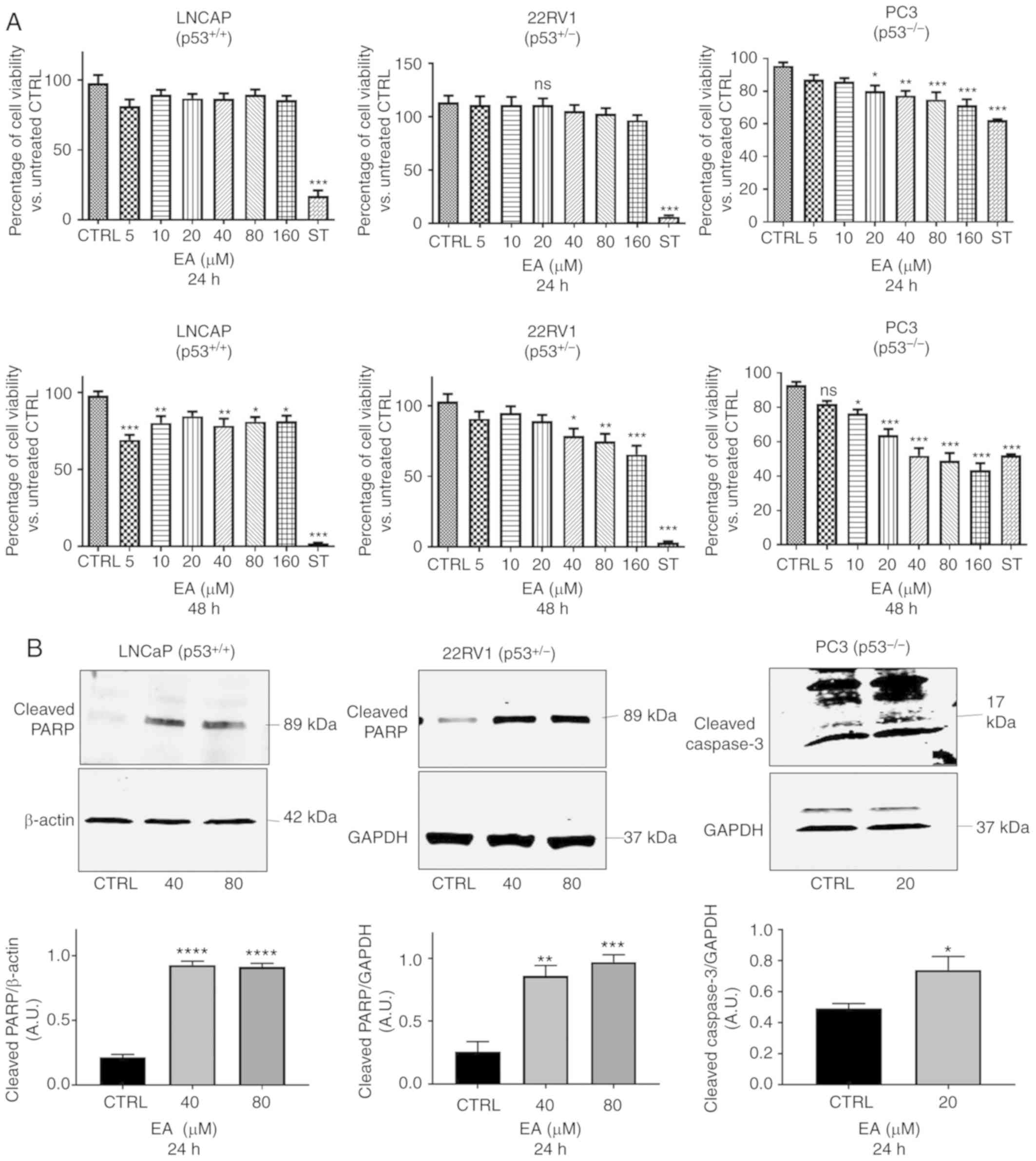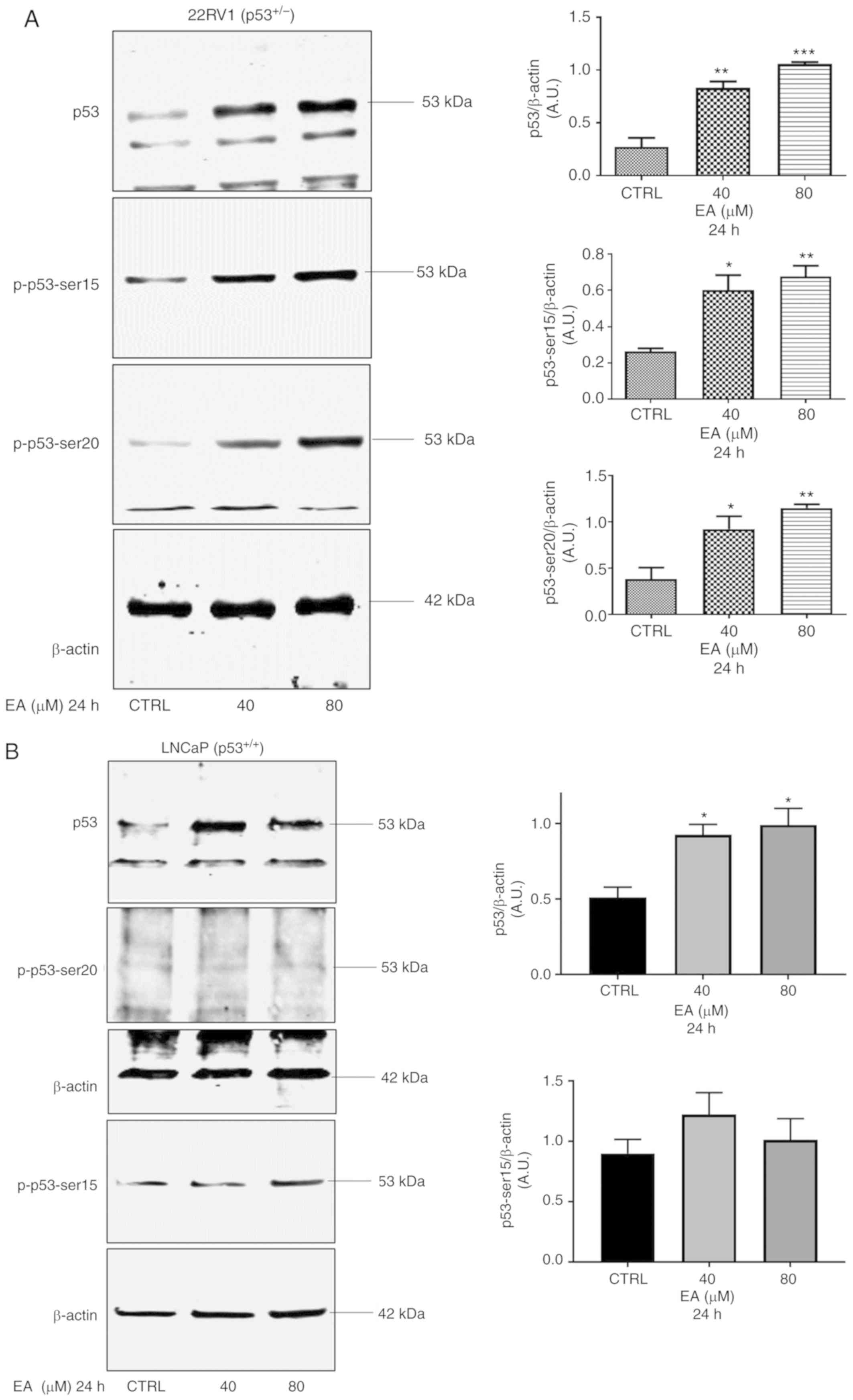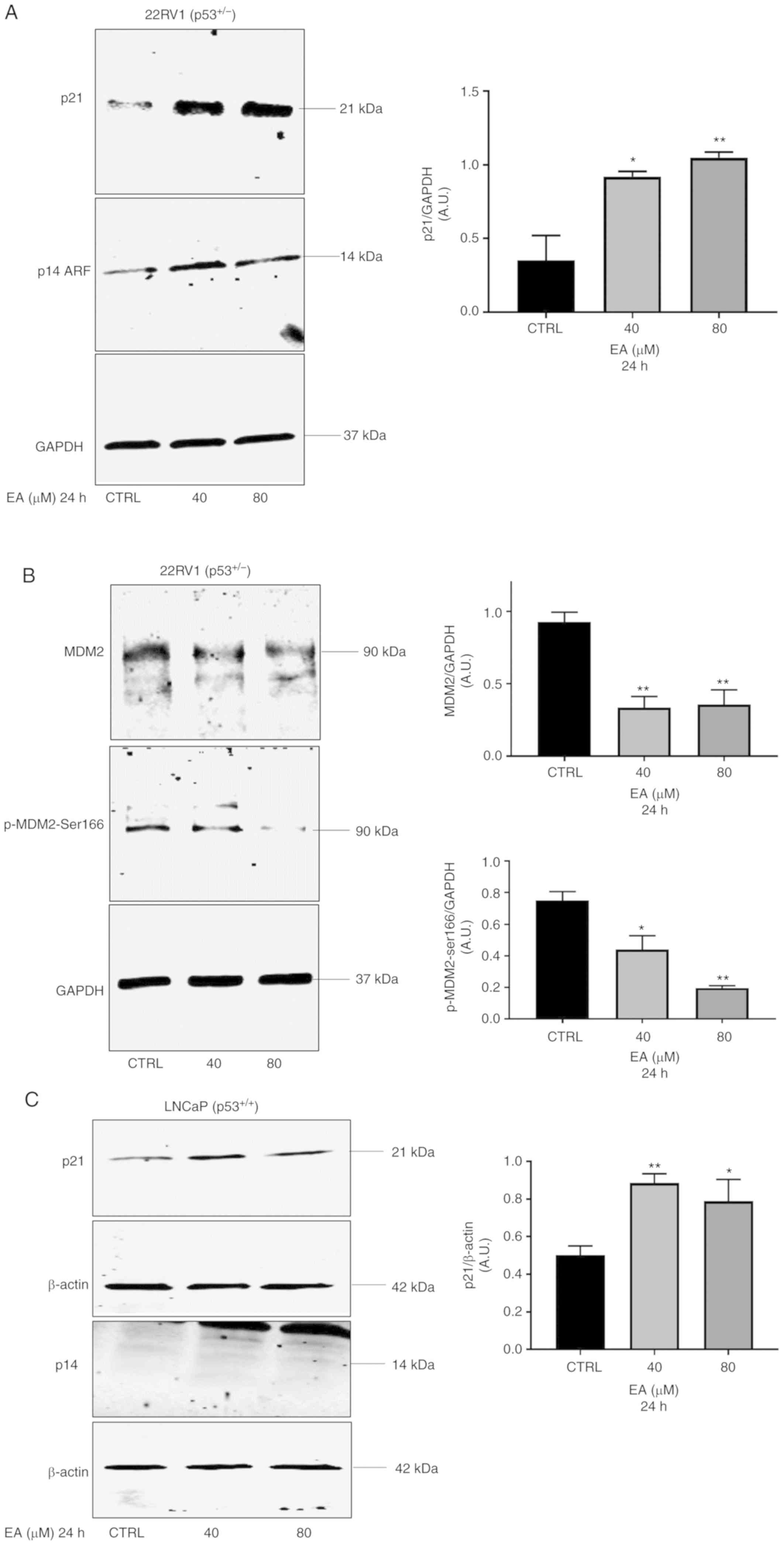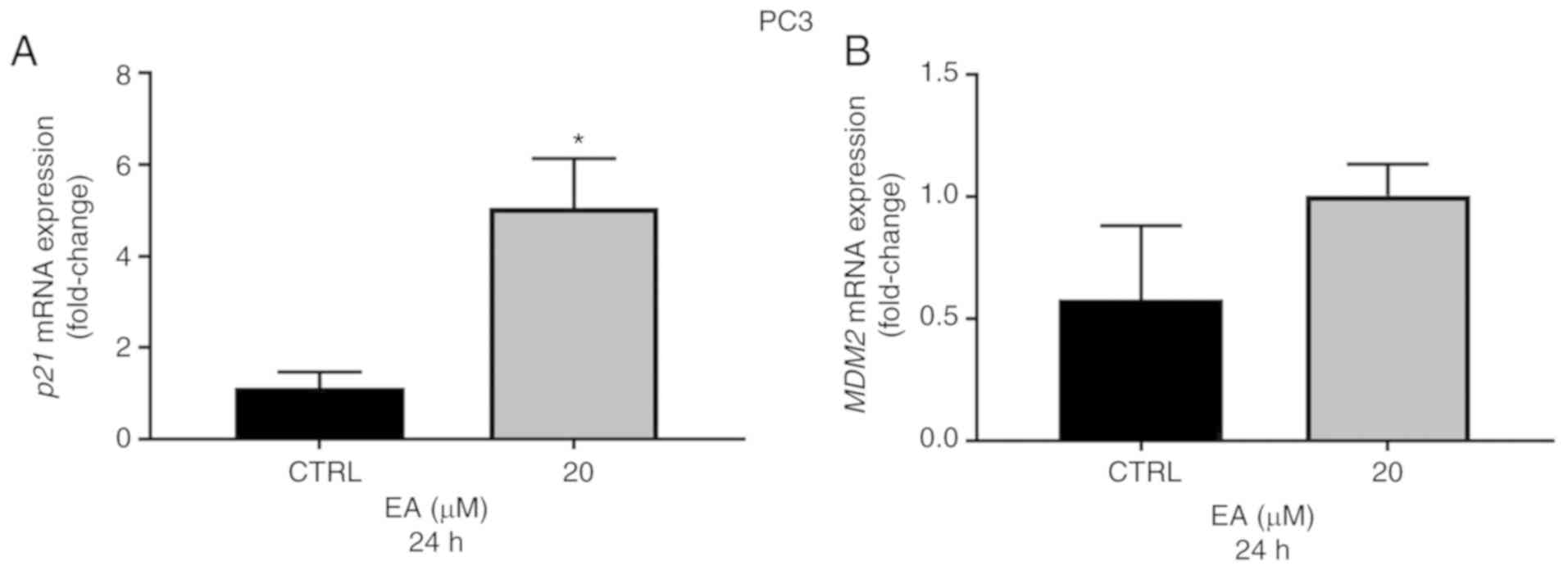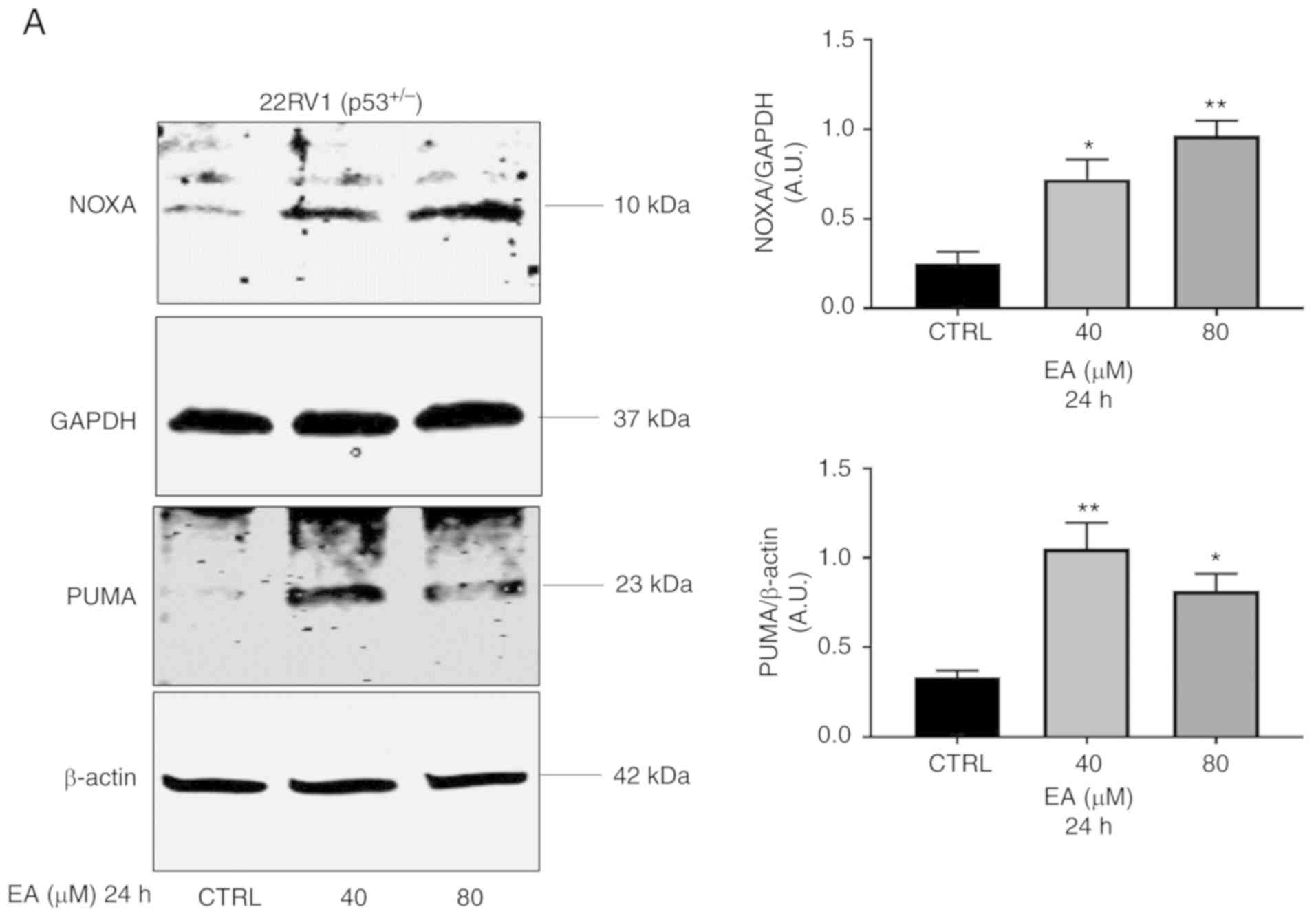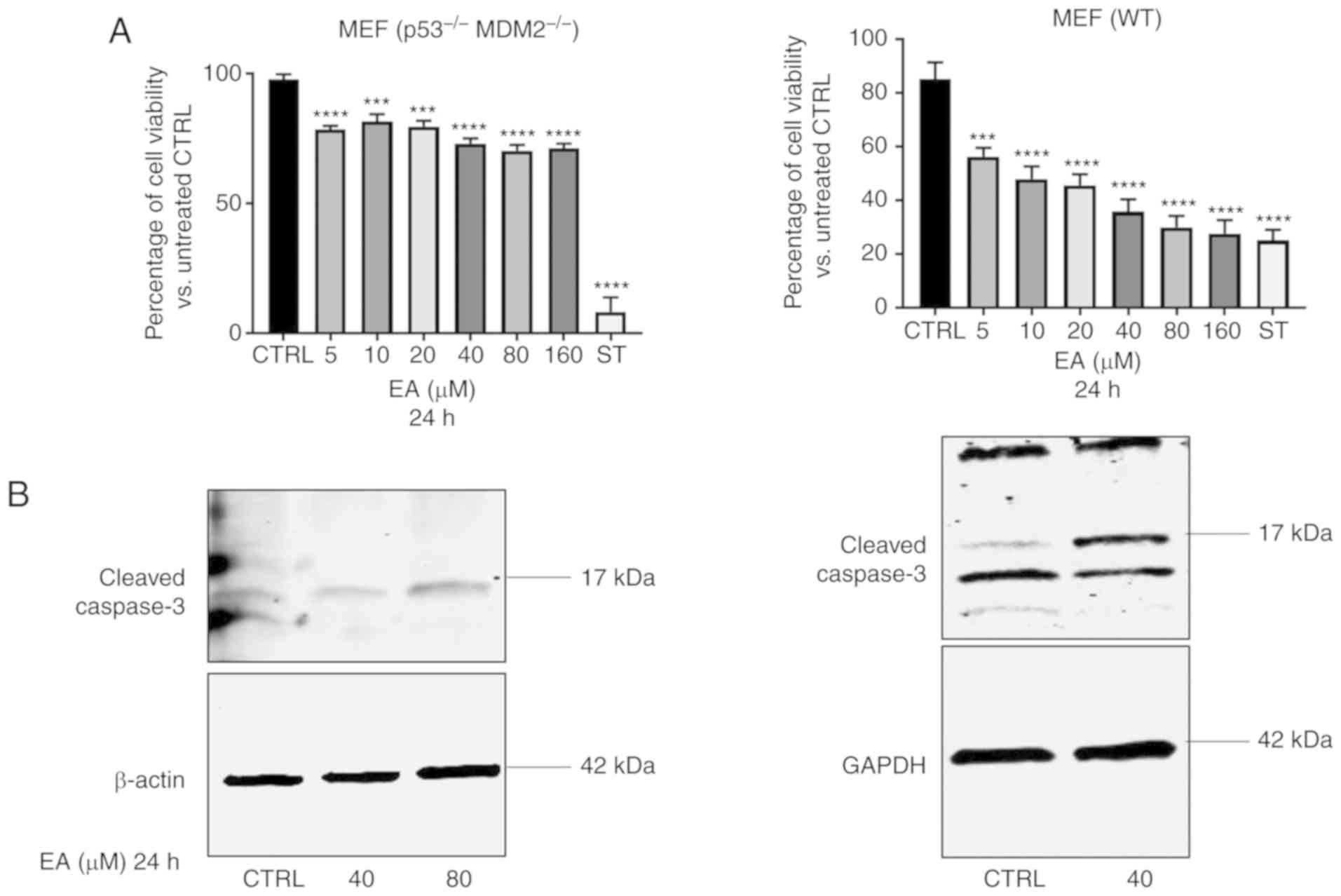MDM2 as a target for ellagic acid‑mediated suppression of prostate cancer cells in vitro
- Authors:
- Published online on: June 26, 2020 https://doi.org/10.3892/or.2020.7664
- Pages: 1255-1265
Abstract
Introduction
Prostate cancer (PCa) is the most common cancer in men and the second leading cause of cancer-related mortality in men worldwide (1). Because of the limited treatment options available for PCa, patients may experience disease relapse and are often treated with anti-androgen therapy (2). However, advanced PCa results from the emergence of androgen-independent PCa and eventually must be treated with chemotherapy. Although docetaxel-based therapy is mostly used in advanced PCa, patients show low survival rates when taking docetaxel, limiting the treatment options available for advanced PCa (3). Therefore, targeting PCa independently with chemotherapy is crucial. p53 is a transcription factor known as the guardian of the genome because it is involved in the transcription of regulatory genes that control cell apoptosis, cell cycle arrest, and DNA repair (4). p53 causes cell-cycle arrest by activating the cyclin-dependent kinase inhibitor p21 (4). In addition, p53 induces apoptosis by activating the mitochondrial pro-apoptotic proteins p53 upregulated modulator of apoptosis (PUMA) [also known as Bcl-2-binding component 3 (BBC3)] and Phorbol-12-myristate-13-acetate-induced protein 1 (NOXA) (5). p53 undergoes post-translation modification (PTM) at several sites in response to DNA damage and oncogene activation in a cell (4,6). The p53 PTM enables it to be activated and stabilized after DNA damage (4). It was previously shown that phosphorylation and acetylation of p53 enhance the transcription of its target genes (7–9). On the other hand, p53 also undergoes ubiquitination and sumoylation, which are associated with the nuclear export of p53 and with the inhibition of p53 transcriptional activities (10–12). The TP53 gene is mutated in about 50% of cancers (13,14). On the other hand, p53 still retains its wild-type status in about 50% of carcinomas, but its activity is diminished. Murine double minute-2 (MDM2), an E3 ligase enzyme, is the major negative regulator of p53 that is overexpressed in half of the cancers, including PCa (15). MDM2 is also a target gene for p53, helping to establish an autoregulatory feedback loop in which p53 promotes the transcription of its negative regulator (16). MDM2 regulates p53 by three main mechanisms, as follows: It inhibits p53 transcriptional activity, exports p53 from the nucleus, and ubiquitinates p53 and degrades it in the proteasome (17,18). Thus, MDM2 becomes a promising target for cancer therapy in cancers that are harboring wild-type p53 (19). Although MDM2 is the main negative regular of p53, it also regulates other proteins independently of p53 (16). Among these proteins is X-linked inhibitor of apoptosis protein (XIAP) protein that is known for its inhibition to caspase 3 (18).
Epidemiological studies, including PCa cell lines and in vivo xenograft models, suggest that the consumption of a selected variety of fruits and vegetables rich in polyphenolic compounds is effective against several types of cancer (20, 21). The pomegranate, a widely consumed fruit, suppresses the growth of several cancers, including PCa (22,23). The effect of the pomegranate on cancers is attributed to its polyphenolic compounds, particularly ellagic acid (EA) and urolithin A (UA), which are potent antioxidants with anticancer activity (24,25). Previous studies have shown that EA causes PCa cell inhibition, cell cycle arrest, and apoptosis in 22RV1, DU-145, PC3, and LNCaP PCa cell lines (23,26–28). In addition, EA has been shown to inhibit vascular endothelial growth factor in LNCaP cells, which is responsible for cancer angiogenesis (29). In addition to the in vitro studies, some investigators have extended the in vitro observation to in vivo. For example, using immunodeficient murine models of PCa, the authors found EA reduced angiogenesis and metastasis formation (30). However, these effects were not by EA alone since EA was given in combination with other polyphenols, luteolin, and punicic acid (30). Another study showed that EA inhibited PCa carcinogenesis in vivo (25). Thus, EA interferes with multiple biological processes involved in PCa initiation, angiogenesis, and metastasis (31). Although these and other investigations have confirmed the anticancer effect of EA on PCa, the mechanisms by which EA influences the p53/MDM2 pathway in PCa remain incompletely understood. We have recently demonstrated that EA's metabolite, UA, increased p53 expression, and inhibited MDM2-mediated p53 polyubiquitination (32). The aim of the present study was to investigate the influence of EA on the p53/MDM2 signaling pathway in PCa cells. Here, we confirmed the effect of the parent compound, EA, on the p53/MDM2 pathway by downregulating MDM2 and upregulating p53. Our data suggest that EA suppresses PCa progression partly via targeting the p53/MDM2 pathway.
Materials and methods
Cell cultures
Human PCa LNCaP, 22RV1, and PC3 cell lines were obtained from the American Type Culture Collection (ATCC). Both LNCaP and 22RV1 cell lines were grown using RPMI-1640 media (ATCC) containing 10% fetal bovine serum (FBS), penicillin (100 mg/ml) and streptomycin (100 mg/ml). PC3 cells were grown using F12 knight media (ATCC) containing 10% FBS, penicillin (100 mg/ml) and streptomycin (100 mg/ml). Mouse embryonic fibroblast (MEF) cells possessing double knockouts of p53 and MDM2 (p53−/− MDM2−/−) were obtained from Professor Guillermina Lozano (MD Anderson Cancer Center, University of Texas, Austin, TX, USA). Wild-type MEF cells were obtained from ATCC. Both wild-type MEF and MEF (p53−/− MDM2−/−) were grown using DMEM media (ATCC) containing 10% fetal bovine serum (FBS), penicillin (100 mg/ml) and streptomycin (100 mg/ml). All cell lines were grown in a 37°C incubator with 5% CO2 according to ATCC protocols.
Reagents and antibodies
EA was purchased from Santa Cruz Biotechnology, Inc. Anti-cleaved PARP (cat. no. 5625), anti-cleaved caspase-3 (cat. no. 9661), anti-phospho-MDM2-ser166 (cat. no. 3521), anti-p14ARF (cat. no. 2407) anti-PUMA (cat. no. 12450), anti-NOXA (cat. no. 14766), anti-phospho-p53-ser15 (cat. no. 9284), anti-phospho-p53-ser 20 (cat. no. 9287), anti-XIAP (2042T), anti-GAPDH (cat. no. 2118) and anti-β-actin (cat. no. 3700) antibodies were purchased from Cell Signaling Biotechnology, Inc. Anti-MDM2 antibody (cat. no. 556353) was purchased from BD Biosciences. Anti-p53 (sc-126) and anti-p21 (sc-6246) antibodies were purchased from Santa Cruz Biotechnology, Inc.
Cell viability assay
All cells were incubated in 96-well plates overnight at a concentration of 120,000 cells/ml to allow them to adhere and to reach 70% confluency before treatment. Cells were then treated with EA at concentrations of 5, 10, 20, 40, 80 and 160 µM. DMSO was used to dissolve EA and was used as a control (CTRL) at a final concentration of 0.08%, while staurosporine (ST) was used as a positive control. Cell viability was measured using the CellTiter-Glo® luminescent assay (Promega Corp.) after 24 and 48 h of EA treatment according to the manufacturer's protocol.
Immunoblotting (IB)
Immunoblotting was conducted as described previously (33). Cells were cultured in 100-mm plates at a concentration of 120,000 cells/ml and incubated for 24 h in a 37°C incubator. Following incubation, cells were treated for 24 or 48 h with either EA (20, 40 and 80 µM) or vehicle control prepared in serum-free medium. Protein lysates were extracted using 1X cell lysis buffer containing 20 mM Tris-HCl (pH 7.5) 150 mM NaCl, 1 mM Na2EDTA, 1 mM EGTA, 1% Triton, 2.5 mM sodium pyrophosphate, 1 mM β-glycerophosphate, 1 mM Na3VO4 and 1 µg/ml leupeptin (Cell Signaling Technology, Inc.). The dishes were then scraped, and the lysate was collected in a microcentrifuge tube and placed on ice for 30 min. The lysate was then passed through a 21-gauge needle to break up the cell aggregates. The cell lysate was centrifuged at 14,000 × g for 10 min and was quantified by BCA reagent (Thermo Fisher Scientific, Inc.). An amount 30 µg of protein lysate for each sample was loaded equally onto SDS-PAGE for separation using gradient (4-20%) gels (Bio-Rad Laboratories). The gel was then transferred to a nitrocellulose membrane (Bio-Rad Laboratories) using Trans-Blot Turbo Transfer System (Bio-Rad Laboratories) with transfer buffer (containing 230 mM glycine, 25 mM Tris, 0.7 mM SDS, 20% methanol). The membrane was then blocked using Odyssey blocking buffer (LI-COR Biosciences) for 1 h at room temperature to block the nonspecific binding sites on the membrane. The membrane was then incubated at 4°C overnight with blocking buffer containing p53 (1:1,000), p-p53-ser 15 (1:1,000), p-p53-ser20 (1:1,000), MDM2 (1:500), p-MDM2 ser166 (1:1,000), p21 (1:500), cleaved caspase 3 (1:1,000), cleaved PARP (1:1,000), p14ARF (1:500), NOXA (1:500), PUMA (1:1,000), XIAP (1:1,000), GAPDH (1:1,000) and β-actin (1:1,000). The membrane then was washed three times with Tris-buffered saline with 0.1% Tween 20 (TBST), and then incubated for 1 h at room temperature with a blocking buffer containing the appropriate secondary antibody (1:15,000). Protein bands were visualized using the LI-COR Odyssey CLx imaging system (LI-COR Biosciences). The loading controls used for western blotting were GAPDH and β-actin. The densitometry for each band was measured using ImageJ 1.5k software (National Institutes of Health, Bethesda). Each band was normalized to its corresponding loading control as shown on the y-axis for each quantitative analysis of the western blot.
Quantitative real-time polymerase chain reaction (RT-qPCR)
PCa cells were treated with 40 and 80 µM of EA for 24 h for 22RV1 and LNCaP cell lines, respectively, and 20 µM of EA for PC3 cells also for 24 h. Total RNA was extracted and purified from the cell lines using the miRNeasy Mini kit (Qiagen) according to the manufacturer's guidelines. The complementary DNA was generated from the total RNA by using the iScript cDNA Synthesis kit (Bio-Rad Laboratories). The quantitative real-time polymerase chain reaction was performed with a real-time thermal cycler (Bio-Rad Laboratories) using SsoAdvanced™ Universal SYBR® Green Supermix (Bio-Rad Laboratories). RT-qPCR reactions were conducted for 40 cycles. Each cycle included denaturation (95°C for 39 sec), annealing (57°C for 30 sec), and extension (60°C for 30 sec). Specific primers were used as follows: For human P21 forward (CTGAGACTCTCAGGGTCGAA) and reverse (CGGCGTTTGGAGTGGTAGAA); for human MDM2 forward (TGGCGTGCCAAGCTTCTCTGT) and reverse (ACCTGAGTCCGATGATTCCTGCT); for human GAPDH forward (CAGCCTCAAGATCATCAGCA) and reverse (GTCTTCTGGGTGGCAGTGAT). The mRNA expressions of MDM2 and P21 were calculated using the 2−ΔΔCq method (34), with the GAPDH as an internal control, and data were represented as fold change.
Statistical analysis
All data are representative of three or more independent experiments. Data are presented as mean ± standard error of the mean (SEM). Unpaired student's T-test was used to compare two groups. One-way ANOVA, followed by Dunnett's multiple comparison tests were performed to compare three groups. Data were generated using GraphPad Prism v7.04 (GraphPad Software, Inc.). P<0.05 was considered to indicate a statistically significant difference.
Results
EA induces apoptosis in PCa cells
Different concentrations of EA were used for cell viability assay ranging from 5 to 160 µM for 24 and 48 h. For 22RV1 and LNCaP cell lines, EA did not promote any significant decrease in cell viability after 24 h of treatment compared with the vehicle control (Fig. 1A). Separately, for PC3 cells, EA significantly inhibited PC3 cell viability after 24 h, starting at 20 µM. On the other hand, PCa cell viability was decreased in all cell lines after 48 h compared with the vehicle control (Fig. 1A; lower panel). We further confirmed the apoptotic effect at 24 h at 40 and 80 µM EA in the LNCaP and 22RV1 cell lines (Fig. 1B). Although EA did not affect cell viability at 24 h, it enhanced the expression of cleaved PARP in the LNCaP and 22RV1 cell lines compared with the vehicle control, suggesting apoptosis at 24 h following treatment with 40 and 80 µM EA (Fig. 1B). For PC3 cells, cleaved caspase-3 was significantly increased after treatment with 20 µM of EA for 24 h when compared with the vehicle control (Fig. 1B; right panel). Since we aimed to ascertain the effect of EA on MDM2 and p53 at the same concentrations that caused apoptosis, we continued to use 40 and 80 µM for subsequent experiments.
EA increases p53 protein expression and enhances the expression of p53 target proteins
Following the results of apoptosis, we sought to investigate the effect of EA on p53 expression. The p53 protein level was significantly increased in 22RV1 and LNCaP with 40 and 80 µM of EA at 24 h after treatment compared with the vehicle control (Fig. 2A and B). Previous studies have shown that many polyphenols increase p53 expression by inducing DNA damage (35); thus we investigated the effects of EA on p53 PTM, particularly phosphorylation. We found that EA increased phosphorylated p53 (p-p53) at ser15 and ser20 in the case of 22RV1 (Fig. 2A). On the other hand, the increase in phosphorylated p53 at ser15 was not significant in LNCaP following treatment with EA at both concentrations used, and no expression of phosphorylated p53 at ser20 was detected in LNCaP cells (Fig. 2B).
Next, we investigated the effects of EA on p53 main target proteins, MDM2, and p21. As expected, the protein level of p21 was increased by 40 and 80 µM EA in both 22RV1 and LNCaP cell lines at 24 h compared with the vehicle control (Fig. 3A and C). Importantly, the p21 gene and protein expressions were also significantly elevated in PC3 (p53−/−) cells following 20 µM EA at 24 h when compared with the vehicle control (Figs. 3E and 4A). Of note, although MDM2 is also a target gene for p53, the protein expression of MDM2 was significantly decreased in all cell lines examined in this study when compared with the vehicle control (Fig. 3B, D and E). Moreover, EA at 40 and 80 µM downregulated phosphorylated MDM2 (p-MDM2) at ser166 in 22RV1 and LNCaP cells at 24 h when compared with the vehicle control (Fig. 3B and D). To further understand the nature of the MDM2 protein downregulation promoted by EA, we investigated the effects of EA on MDM2 mRNA expression. As expected, 40 and 80 µM EA caused the downregulation of MDM2 gene expression in both 22RV1 and LNCaP cell lines at 24 h when compared with the vehicle control (Fig. 4C and D) although the decrease was not significant at 80 µM in 22RV1 cells. However, the gene expression of MDM2 was not significantly changed in PC3 cells following treatment with 20 µM EA at 24 h when compared with the vehicle control (Fig. 4B). To further understand the MDM2 downregulation by EA, we also investigated the effects of EA on the MDM2/p14ARF pathway in PCa cells. Interestingly, p14ARF was markedly increased in 22RV1 and PC3 cells (Fig. 3A and E) but not in LNCaP cells (Fig. 3C).
EA induces apoptosis in a p53-dependent and -independent manner
p53 provokes apoptosis mainly through the induction of the pro-apoptotic proteins PUMA and NOXA (36). We therefore examined the effects of EA on expression levels of these proteins. As expected, EA increased the levels of PUMA and NOXA in 22RV1 and LNCaP cells at 40 and 80 µM at 24 h when compared with the vehicle control (Fig. 5A and B). To validate the apoptotic effect in PC3 cells in the absence of p53, we separately found that EA significantly downregulated XIAP protein at 20 µM at 24 h compared with the vehicle control, leading to increase cleaved caspase-3 (Fig. 5C). These data suggest that EA induces apoptosis in a p53-dependent and -independent manner by downregulating MDM2.
Effects of EA are independent of p53 and MDM2
The above results showed that EA induces PCa suppression via targeting MDM2 and activating p53. To further examine the effect of EA on the status of p53 and MDM2, we used MEF cells that have double knockouts for both p53 and MDM2 (p53−/− MDM2−/−). Cell viability assay showed that EA did inhibit MEF cell viability at the concentration range of from 5 to 160 µM at 24 h in both the WT and double knockout MEF cells (Fig. 6A; upper panel). Moreover, EA induced cleaved caspase-3 expression In both the WT and double knockout MEF cells, suggesting apoptosis was induced independently of p53 and MDM2 (Fig. 6B; lower panel).
Discussion
EA is a naturally occurring polyphenolic compound that is derived from punicalagins (23). Although EA is known for its ability to induce cytotoxic effects in several types of cancer, including PCa (37), the influence of EA on MDM2 and p53 in PCa is not yet fully understood. We confirmed that EA induced apoptosis by increasing the expression of cleaved PARP in LNCaP, 22RV1, and PC3 cell lines, although no significant effect was found on the viability of PCa cells after 24 h. We assumed this discrepancy between cell viability assay and apoptosis after 24 h is that apoptosis is an early event in cell death, while cell viability is reduced at the late stage of apoptosis. We further confirmed this by analyzing the viability after 48 h, finding that EA suppressed PCa cell viability. Moreover, we chose 40 and 80 µM as these two concentrations caused a significant effect on apoptosis after 24 h. Since we aimed to ascertain the effect of EA on MDM2 and p53 at the same concentrations that caused apoptosis, we used 40 and 80 µM for all other experiments. To note, EA reduced the LNCaP cell viability at a low concentration. In a separate experiment, we found that EA induced apoptosis at a low concentration but without affecting the p53 and MDM2 at low concentration (data not shown). We conclude that EA can induce apoptosis at a low concentration in a pathway that is independent of the p53-MDM2 pathway; such a pathway requires a high concentration of EA to get stimulated. Vanella et al (28) showed that EA induced LNCaP cell death by targeting the mTOR pathway and lowering the intracellular level of β-catenin. Moreover, their study also showed that EA increased the expression of p21 in LNCaP cells (28).
In the present study, we demonstrated the influences of EA on the p53/MDM2 pathway in PCa in vitro using three models of PCa that each harbor a distinct TP53 gene. Our western blot data indicated that EA increased the p53 protein level. p53 activation is mainly regulated by phosphorylation and acetylation, which are part of the post-translation modification (PTM) of p53 (6). Phosphorylation of p53 at ser15 occurred as a response to DNA damage that resulted from a single- or double-strand break (38). Previous research has shown that other polyphenols induce p53 expression by inducing DNA damage, which triggers the ATM/CHK kinases that cause phosphorylation to the p53 (35). Here, we found that EA induced phosphorylation of p53 at ser15 in 22RV1 cells, indicating a DNA damage mechanism induced by EA in 22RV1 cells. However, p53-ser 15 was not significantly increased after EA treatment in LNCaP cells, suggesting that EA does not produce DNA damage effects in LNCaP as it does in 22RV1 cells. Prior research showed that phosphorylation of p53 at ser20 weakens the interaction between p53 and MDM2 (19). In our study, we found EA only induces the phosphorylation of p53 at ser20 in 22RV1 cells, but not in LNCaP cells. Moreover, the increased level of p53 protein achieved by EA was accompanied by increases in p53′s main target protein, p21, in both 22RV1 and LNCaP cells, suggesting cell-cycle arrest of PCa by EA in these cells. This finding is in agreement with those previously reported by Vanella et al (28,29). p53 is negatively regulated by MDM2, which itself is a target gene of p53, forming an autoregulatory feedback loop. We recently found that a metabolite of EA, urolithin A (UA), increased p53 protein expression, and that this increase was accompanied by increases in MDM2 gene and protein expression, forming an autoregulatory feedback loop (32). Interestingly, although the level of p53 was increased by EA, we found that EA did not increase MDM2 protein expression as a feedback loop but did downregulate it. We speculated the MDM2 downregulation by EA may be occurring at the transcriptional level or via other MDM2 regulators. p14ARF, another tumor suppressor, is known to inhibit the p53–MDM2 interaction and MDM2 ligase activity (39). A previous study revealed that apigenin downregulated MDM2 by increasing p14ARF in 22RV1 cells (40). In 22RV1 and PC3 cells treated with EA, we found that p14ARF was increased, suggesting a possible mechanism of MDM2 downregulation by EA. However, p14AFR was not increased in LNCAP cells, indicating that EA may affect either the gene expression of MDM2 or affect MDM2 at the protein level. Our data showed that EA downregulated MDM2 mRNA in LNCaP and 22RV1 cells, further explaining the MDM2 protein downregulation. We concluded that the downregulation of MDM2 by EA suggested that EA inhibited the ligase activity of MDM2, preventing p53 ubiquitination and degradation. On the other hand, the MDM2 mRNA level was not altered in PC3 cells, suggesting that EA downregulates MDM2 protein expression by inducing p14ARF or that EA may affect MDM2 protein directly. Interestingly, the gene and protein expressions of p21 were also increased in PC3 cells independently of p53. These results are in agreement with those of a previous study that confirmed p21 expression in the absence of p53 (41). Moreover, MDM2 itself can negatively regulate p21 in a p53-independent manner (42). Therefore, we speculate that the MDM2 downregulation by EA in PC3 cells may aid in the increased in protein expression of p21. It is known that p53 produces apoptosis when the p53 protein level reaches the apoptotic threshold (43). Upon reaching the apoptotic threshold, p53 induces the expression of two main pro-apoptotic proteins, p53 upregulated modulator of apoptosis (PUMA) [also known as Bcl-2-binding component 3 (BBC3)] and Phorbol-12-myristate-13-acetate-induced protein 1 (NOXA). (36). PUMA and NOXA can bind the mitochondrial antiapoptotic proteins Bcl-2, Bcl-X, and MCL-1 (36), producing an intrinsic apoptotic effect. In the present study, the increased level of p53 by EA was accompanied by increases in PUMA and NOXA, suggesting p53-dependent apoptosis by EA.
MDM2 is phosphorylated by AKT at ser166, enabling it to enter the nucleus, where it binds and inhibits the transcriptional activity of p53 (44). In the present study, we found that EA downregulated phosphorylated MDM2 in LNCaP and 22RV1 cells at ser166, restoring the activity of p53 and its target genes. Our data on mouse embryonic fibroblasts (MEFs) (p53−/−, MDM2−/−) suggest that the influence of EA on the p53-MDM2 pathway may be partly contributed to the cytotoxic effect of EA on PCa.
All these mechanisms of EA on the p53-MDM2 pathway demonstrate its effectiveness in suppressing PCa through this pathway in vitro. However, EA has low bioavailability after consumption of pomegranate or other dietary sources in other fruits (45). The poor bioavailability of EA will eventually limit the metabolically active urolithins, limiting the therapeutic effectiveness of these compounds after consumption of pomegranate (46). In the current study, we selected 40 and 80 µM concentrations of EA and UA because they showed significant apoptotic effect after a 24-h treatment and a significant effect on p53 and its target genes and proteins in vitro. We acknowledge that these concentrations are not bioavailable after consumption of pomegranate. Therefore, the current research suggests that EA can be useful to treat PCa if both are extracted from pomegranate or other dietary sources. Furthermore, there are recent efforts by researchers to improve the bioavailability of EA (47,48), which will focus on improving EA drug delivery to cancer sites, including PCa.
In conclusion, this study demonstrated the role of the natural polyphenol EA in the suppression of PCa cell growth by inhibiting the oncogene MDM2 and inducing p53 protein expression and its target proteins. However, further experiments are required to validate these data; for example, using luciferase reporter assay for p53 before and after EA treatment in PCa cells will be useful to validate the gene expression by p53. Moreover, RNA-seq analysis will be useful to validate the alteration in gene expression by p53. Additionally, it may be useful to observe the effect of EA on AKT to validate the EA effect on the phosphorylated MDM2 at ser-166. Furthermore, Annexin V apoptotic assay using flow cytometry will be helpful in validating the apoptotic effect by EA. A major problem with MDM2 inhibitors is that they produce p53 accumulation in normal cells, causing toxicity to normal cells. Therefore, further research is needed to examine the concept of p53 accumulation in a normal prostate cell line provoked by EA.
Acknowledgements
Not applicable.
Funding
The present study was funded by the Department of Pharmacology and Toxicology at East Carolina University (Greenville, NC, USA).
Availability of data and materials
The datasets used during the present study are available from the corresponding author upon reasonable request.
Authors' contributions
YIMS and MS conceptualized the study. YIMS designed the study and performed all the experiments and analyzed the data. YIMS wrote the manuscript, and MS revised the manuscript. All authors read and approved the final manuscript.
Ethics approval and consent to participate
Not applicable.
Patient consent for publication
Not applicable.
Competing interests
The authors declare that they have no competing interests.
References
|
Ferlay J, Soerjomataram I, Dikshit R, Eser S, Mathers C, Rebelo M, Parkin DM, Forman D and Bray F: Cancer incidence and mortality worldwide: Sources, methods and major patterns in GLOBOCAN 2012. Int J Cancer. 136:E359–E386. 2015. View Article : Google Scholar : PubMed/NCBI | |
|
Wirth MP, Hakenberg OW and Froehner M: Antiandrogens in the treatment of prostate cancer. Eur Urol. 51:306–313, discussion 314. 2007. View Article : Google Scholar : PubMed/NCBI | |
|
Logan IR, McNeill HV, Cook S, Lu X, Lunec J and Robson CN: Analysis of the MDM2 antagonist nutlin-3 in human prostate cancer cells. Prostate. 67:900–906. 2007. View Article : Google Scholar : PubMed/NCBI | |
|
Toufektchan E and Toledo F: The guardian of the genome revisited: p53 downregulates genes required for telomere maintenance, DNA repair, and centromere structure. Cancers (Basel). 10:1352018. View Article : Google Scholar | |
|
Brady CA and Attardi LD: p53 at a glance. J Cell Sci. 123:2527–2532. 2010. View Article : Google Scholar : PubMed/NCBI | |
|
Jin L, Li C, Xu Y, Wang L, Liu J, Wang D, Hong C, Jiang Z, Ma Y, Chen Q and Yu F: Epigallocatechin gallate promotes p53 accumulation and activity via the inhibition of MDM2-mediated p53 ubiquitination in human lung cancer cells. Oncol Rep. 29:1983–1990. 2013. View Article : Google Scholar : PubMed/NCBI | |
|
Kruse JP and Gu W: SnapShot: p53 posttranslational modifications. Cell. 133:930–30.e1. 2008. View Article : Google Scholar : PubMed/NCBI | |
|
Muñoz-Fontela C, González D, Marcos-Villar L, Campagna M, Gallego P, González-Santamaría J, Herranz D, Gu W, Serrano M, Aaronson SA and Rivas C: Acetylation is indispensable for p53 antiviral activity. Cell Cycle. 10:3701–3705. 2011. View Article : Google Scholar : PubMed/NCBI | |
|
Sakaguchi K, Herrera JE, Saito S, Miki T, Bustin M, Vassilev A, Anderson CW and Appella E: DNA damage activates p53 through a phosphorylation-acetylation cascade. Genes Dev. 12:2831–2841. 1998. View Article : Google Scholar : PubMed/NCBI | |
|
Jimenez GS, Khan SH, Stommel JM and Wahl GM: p53 regulation by post-translational modification and nuclear retention in response to diverse stresses. Oncogene. 18:7656–7665. 1999. View Article : Google Scholar : PubMed/NCBI | |
|
Lee JT and Gu W: The multiple levels of regulation by p53 ubiquitination. Cell Death Differ. 17:86–92. 2010. View Article : Google Scholar : PubMed/NCBI | |
|
Yuan J, Luo K, Zhang L, Cheville JC and Lou Z: USP10 regulates p53 localization and stability by deubiquitinating p53. Cell. 140:384–396. 2010. View Article : Google Scholar : PubMed/NCBI | |
|
Olivier M, Hollstein M and Hainaut P: TP53 mutations in human cancers: Origins, consequences, and clinical use. Cold Spring Harb Perspect Biol. 2:a0010082010. View Article : Google Scholar : PubMed/NCBI | |
|
Robles AI and Harris CC: Clinical outcomes and correlates of TP53 mutations and cancer. Cold Spring Harb Perspect Biol. 2:a0010162010. View Article : Google Scholar : PubMed/NCBI | |
|
Leite KR, Franco MF, Srougi M, Nesrallah LJ, Nesrallah A, Bevilacqua RG, Darini E, Carvalho CM, Meirelles MI, Santana I and Camara-Lopes LH: Abnormal expression of MDM2 in prostate carcinoma. Mod Pathol. 14:428–436. 2001. View Article : Google Scholar : PubMed/NCBI | |
|
Bohlman S and Manfredi JJ: p53-independent effects of Mdm2. Subcell Biochem. 85:235–246. 2014. View Article : Google Scholar : PubMed/NCBI | |
|
Alarcon-Vargas D and Ronai Z: p53-Mdm2 - the affair that never ends. Carcinogenesis. 23:541–547. 2002. View Article : Google Scholar : PubMed/NCBI | |
|
Nag S, Qin J, Srivenugopal KS, Wang M and Zhang R: The MDM2-p53 pathway revisited. J Biomed Res. 27:254–271. 2013.PubMed/NCBI | |
|
Moll UM and Petrenko O: The MDM2-p53 interaction. Mol Cancer Res. 1:1001–1008. 2003.PubMed/NCBI | |
|
Khan N, Bharali DJ, Adhami VM, Siddiqui IA, Cui H, Shabana SM, Mousa SA and Mukhtar H: Oral administration of naturally occurring chitosan-based nanoformulated green tea polyphenol EGCG effectively inhibits prostate cancer cell growth in a xenograft model. Carcinogenesis. 35:415–423. 2014. View Article : Google Scholar : PubMed/NCBI | |
|
Robson CH, Ganapathy M, Swanson GP, Natarajan M, Papanikolaou N, Hanes MA, Yeh IT, Ghosh R and Kumar AP: Phellodendron amurense bark extract enhances radiosensitivity by inhibition of nf-kappa B in transgenic adenocarcinoma of mouse prostate model and human prostate cancer cells. J Urol. 181((4S)): 4792009. View Article : Google Scholar | |
|
Paller CJ, Pantuck A and Carducci MA: A review of pomegranate in prostate cancer. Prostate Cancer Prostatic Dis. 20:265–270. 2017. View Article : Google Scholar : PubMed/NCBI | |
|
Seeram NP, Adams LS, Henning SM, Niu Y, Zhang Y, Nair MG and Heber D: In vitro antiproliferative, apoptotic and antioxidant activities of punicalagin, ellagic acid and a total pomegranate tannin extract are enhanced in combination with other polyphenols as found in pomegranate juice. J Nutr Biochem. 16:360–367. 2005. View Article : Google Scholar : PubMed/NCBI | |
|
Han DH, Lee MJ and Kim JH: Antioxidant and apoptosis-inducing activities of ellagic acid. Anticancer Res. 26:3601–3606. 2006.PubMed/NCBI | |
|
Naiki-Ito A, Chewonarin T, Tang M, Pitchakarn P, Kuno T, Ogawa K, Asamoto M, Shirai T and Takahashi S: Ellagic acid, a component of pomegranate fruit juice, suppresses androgen-dependent prostate carcinogenesis via induction of apoptosis. Prostate. 75:151–160. 2015. View Article : Google Scholar : PubMed/NCBI | |
|
Losso JN, Bansode RR, Trappey A II, Bawadi HA and Truax R: In vitro anti-proliferative activities of ellagic acid. J Nutr Biochem. 15:672–678. 2004. View Article : Google Scholar : PubMed/NCBI | |
|
Malik A, Afaq S, Shahid M, Akhtar K and Assiri A: Influence of ellagic acid on prostate cancer cell proliferation: A caspase-dependent pathway. Asian Pac J Trop Med. 4:550–555. 2011. View Article : Google Scholar : PubMed/NCBI | |
|
Vanella L, Di Giacomo C, Acquaviva R, Barbagallo I, Cardile V, Kim DH, Abraham NG and Sorrenti V: Apoptotic markers in a prostate cancer cell line: Effect of ellagic acid. Oncol Rep. 30:2804–2810. 2013. View Article : Google Scholar : PubMed/NCBI | |
|
Vanella L, Di Giacomo C, Acquaviva R, Barbagallo I, Li Volti G, Cardile V, Abraham NG and Sorrenti V: Effects of ellagic acid on angiogenic factors in prostate cancer cells. Cancers (Basel). 5:726–738. 2013. View Article : Google Scholar : PubMed/NCBI | |
|
Wang L, Li W, Lin M, Garcia M, Mulholland D, Lilly M and Martins-Green M: Luteolin, ellagic acid and punicic acid are natural products that inhibit prostate cancer metastasis. Carcinogenesis. 35:2321–2330. 2014. View Article : Google Scholar : PubMed/NCBI | |
|
Zhang HM, Zhao L, Li H, Xu H, Chen WW and Tao L: Research progress on the anticarcinogenic actions and mechanisms of ellagic acid. Cancer Biol Med. 11:92–100. 2014.PubMed/NCBI | |
|
Mohammed Saleem YI, Albassam H and Selim M: Urolithin A induces prostate cancer cell death in p53-dependent and in p53-independent manner. Eur J Nutr. 59:1607–1618. 2019. View Article : Google Scholar : PubMed/NCBI | |
|
Van Dross RT: Metabolism of anandamide by COX-2 is necessary for endocannabinoid-induced cell death in tumorigenic keratinocytes. Mol Carcinog. 48:724–732. 2009. View Article : Google Scholar : PubMed/NCBI | |
|
Livak KJ and Schmittgen TD: Analysis of relative gene expression data using real-time quantitative PCR and the 2(-Delta Delta C(T)) method. Methods. 25:402–408. 2001. View Article : Google Scholar : PubMed/NCBI | |
|
Nelly Etienne-Selloum ID, Tanveer Sharif CAa and Schini-Kerth VB: Polyphenolic Compounds Targeting p53-Family Tumor Suppressors. Current Progress and Challenges. 2013. | |
|
Khoo KH, Verma CS and Lane DP: Drugging the p53 pathway: Understanding the route to clinical efficacy. Nat Rev Drug Discov. 13:217–236. 2014. View Article : Google Scholar : PubMed/NCBI | |
|
Ceci C, Lacal PM, Tentori L, De Martino MG, Miano R and Graziani G: Experimental evidence of the antitumor, antimetastatic and antiangiogenic activity of ellagic acid. Nutrients. 10:17562018. View Article : Google Scholar | |
|
Loughery J, Cox M, Smith LM and Meek DW: Critical role for p53-serine 15 phosphorylation in stimulating transactivation at p53-responsive promoters. Nucleic Acids Res. 42:7666–7680. 2014. View Article : Google Scholar : PubMed/NCBI | |
|
Agrawal A, Yang J, Murphy RF and Agrawal DK: Regulation of the p14ARF-Mdm2-p53 pathway: An overview in breast cancer. Exp Mol Pathol. 81:115–122. 2006. View Article : Google Scholar : PubMed/NCBI | |
|
Shukla S and Gupta S: Apigenin-induced prostate cancer cell death is initiated by reactive oxygen species and p53 activation. Free Radic Biol Med. 44:1833–1845. 2008. View Article : Google Scholar : PubMed/NCBI | |
|
Aliouat-Denis CM, Dendouga N, Van den Wyngaert I, Goehlmann H, Steller U, van de Weyer I, Van Slycken N, Andries L, Kass S, Luyten W, et al: p53-independent regulation of p21Waf1/Cip1 expression and senescence by Chk2. Mol Cancer Res. 3:627–634. 2005. View Article : Google Scholar : PubMed/NCBI | |
|
Zhang Z, Wang H, Li M, Agrawal S, Chen X and Zhang R: MDM2 is a negative regulator of p21WAF1/CIP1, independent of p53. J Biol Chem. 279:16000–16006. 2004. View Article : Google Scholar : PubMed/NCBI | |
|
Kracikova M, Akiri G, George A, Sachidanandam R and Aaronson SA: A threshold mechanism mediates p53 cell fate decision between growth arrest and apoptosis. Cell Death Differ. 20:576–588. 2013. View Article : Google Scholar : PubMed/NCBI | |
|
Meek DW and Knippschild U: Posttranslational modification of MDM2. Mol Cancer Res. 1:1017–1026. 2003.PubMed/NCBI | |
|
Seeram NP, Lee R and Heber D: Bioavailability of ellagic acid in human plasma after consumption of ellagitannins from pomegranate (Punica granatum L.) juice. Clin Chim Acta. 348:63–68. 2004. View Article : Google Scholar : PubMed/NCBI | |
|
Bell C and Hawthorne S: Ellagic acid, pomegranate and prostate cancer-a mini review. J Pharm Pharmacol. 60:139–144. 2008. View Article : Google Scholar : PubMed/NCBI | |
|
Bala I, Bhardwaj V, Hariharan S, Kharade SV, Roy N and Ravi Kumar MN: Sustained release nanoparticulate formulation containing antioxidant-ellagic acid as potential prophylaxis system for oral administration. J Drug Target. 14:27–34. 2006. View Article : Google Scholar : PubMed/NCBI | |
|
Jeong YI, Prasad Yv R, Ohno T, Yoshikawa Y, Shibata N, Kato S, Takeuchi K and Takada K: Application of Eudragit P-4135F for the delivery of ellagic acid to the rat lower small intestine. J Pharm Pharmacol. 53:1079–1085. 2001. View Article : Google Scholar : PubMed/NCBI |



